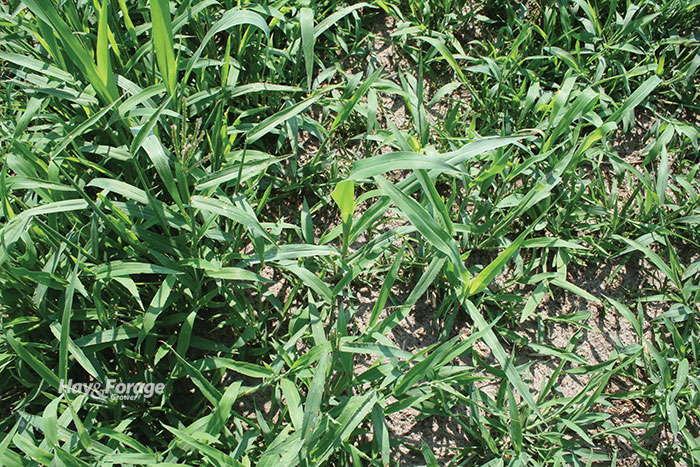A good grass with a reputation problem |
| By Mike Rankin, Managing Editor |
|
|
 Big comebacks are often difficult, but it’s a great story when they do occur. For decades, crabgrass had been cursed as a weed — spat upon by even those with a relatively high weed acceptance bar. Then, suddenly, someone decided crabgrass was not just an acceptable pasture grass, but a really good one. Thereafter, plant breeding efforts were initiated to make crabgrass even better. These days, it’s no longer unusual to be on a grazing farm where crabgrass is a foundational summer forage source. In a recent Off the Hoof newsletter from the University of Kentucky, Chris Teutsch, an extension forage specialist, outlined some key practices to consider for those wanting to join the crabgrass revolution. Use an improved variety because not all crabgrasses are created equal. Newer varieties respond better to higher level management practices. Mix crabgrass with a carrier or use coated seed. Uncoated crabgrass seed will bridge in drills, so mixing the seed with a carrier like pelleted limestone or even some red clover and annual lespedeza seed is beneficial. Seed closely grazed pastures in the late winter or spring. Crabgrass seed will begin to germinate as soil temperatures start to rise. When overseeding pastures, Teutsch recommends using 3 to 4 pounds per acre of uncoated seed or 4 to 6 pounds per acre of coated seed. Drag closely grazed pastures to stimulate crabgrass stands. Dragging closely grazed pastures helps to ensure seed-to-soil contact for improved germination. This is true for both dropped seed from a previous year’s stand or new broadcasted seedings. Teutsch notes that any tillage or dragging should be no deeper than 1/4-inch since crabgrass seed is so small. Apply 60 to 80 pounds of nitrogen to volunteer stands. As with most summer annuals, crabgrass responds well to nitrogen fertilization. Nitrogen fertilizer not only improves dry matter forage yield, but it also boosts the crude protein concentration. Control broadleaf weeds. Once crabgrass seedlings have three to four collared leaves, apply a modest application of 2,4-D to control germinated broadleaf weeds. Allow crabgrass to reach a height of 6 to 8 inches before grazing. This helps crabgrass become well established before grazing, which boosts season-long productivity. Stop grazing at 3 to 4 inches. By leaving residual leaf area, the regrowth of crabgrass will be more rapid and productivity improves. Crabgrass pastures can be grazed again once they reach a height of 6 to 8 inches. Apply 30 to 40 pounds of nitrogen per acre in mid-summer. If soil moisture is adequate, Teutsch recommends applying a small amount of nitrogen in mid-summer. This will boost late-summer growth and improve crude protein levels. Allow stands to go to seed at least once during the growing season. Crabgrass is a summer annual grass that behaves like a perennial through prolific reseeding. Allowing it to go to seed ensures there will be plenty of volunteer seed to germinate in the following year. Plant a winter annual in late summer or early fall. Crabgrass is only productive during the warm months. Planting a winter annual grass like annual ryegrass or a small grain provides late fall or early spring grazing. As the winter annuals are grazed out, crabgrass will germinate and fill in. Another option is to thicken stands up in the fall by interseeding cool-season perennial grasses with a no-till drill. By seeding in the fall, competition from crabgrass and other summer annuals grasses and broadleaves is avoided. |
